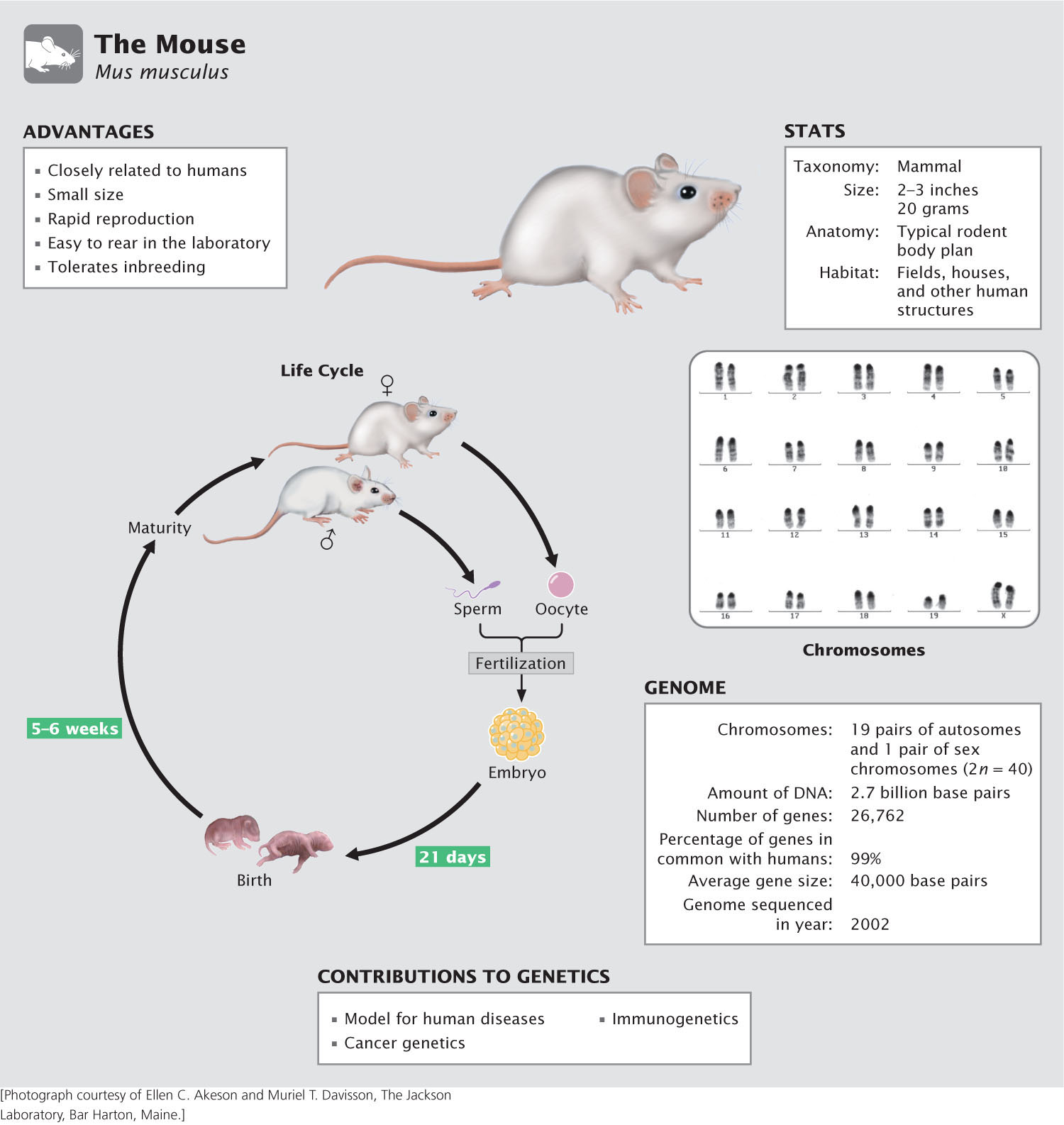The Mouse Mus musculus
The common house mouse, Mus musculus, is among the oldest and most valuable subjects for genetic study. It’s an excellent genetic organism—small, prolific, and easy to keep, with a short generation time.
Advantages of the mouse as a model genetic organism
Foremost among many advantages that Mus musculus has as a model genetic organism is its close evolutionary relationship to humans. Being a mammal, the mouse is genetically, behaviorally, and physiologically more similar to humans than are other organisms used in genetics studies, making the mouse the model of choice for many studies of human and medical genetics. Other advantages include a short generation time compared with that of most other mammals. Mus musculus is well adapted to life in the laboratory and can be easily raised and bred in cages that require little space; thus several thousand mice can be raised within the confines of a small laboratory room. Mice have large litters (8–10 pups), and are docile and easy to handle. Finally, a large number of mutations have been isolated and studied in captive-bred mice, providing an important source of variation for genetic analysis.
Life cycle of the mouse
The production of gametes and reproduction in the mouse are very similar to those in humans. Diploid germ cells in the gonads undergo meiosis to produce sperm and oocytes, as outlined in Chapter 2. Male mice begin producing sperm at puberty and continue sperm production throughout the remainder of their lives. Starting at puberty, female mice go through an estrus cycle about every 4 days. If mating takes place during estrus, sperm are deposited into the vagina and swim into the oviduct, where one sperm penetrates the outer layer of the ovum, and the nuclei of sperm and ovum fuse. After fertilization, the diploid embryo implants into the uterus. Gestation typically takes about 21 days. Mice reach puberty in about 5 to 6 weeks and will live for about 2 years. A complete generation can be completed in about 8 weeks.
The mouse genome
The mouse genome contains about 2.6 billion base pairs of DNA, which is similar in size to the human genome. Mice and humans also have similar numbers of genes. For most human genes, there are homologous genes in the mouse. An important tool for determining the function of an unknown gene in humans is to search for a homologous gene whose function has already been determined in the mouse. Furthermore, the linkage relations of many mouse genes are similar to those in humans, and the linkage relations of genes in mice often provide important clues to linkage relations among genes in humans. The mouse genome is distributed across 19 pairs of autosomes and one pair of sex chromosomes.
Genetic techniques with the mouse
A number of powerful techniques have been developed for use in the mouse. They include the creation of transgenic mice by the injection of DNA into a mouse embryo, the ability to disrupt specific genes by the creation of knockout mice, and the ability to insert specific sequences into specific loci (see Chapter 19). These techniques are made possible by the ability to manipulate the mouse reproductive cycle, including the ability to hormonally induce ovulation, isolate unfertilized oocytes from the ovary, and implant fertilized embryos back into the uterus of a surrogate mother. The ability to create transgenic, knockout, and knock-in mice has greatly facilitated the study of human genetics, and these techniques illustrate the power of the mouse as a model genetic organism.
Mouse and human cells can be fused, allowing somatic-cell hybridization techniques (see Chapter 7) that have been widely used to assign human genes to specific chromosomes. Mice also tolerate inbreeding well, and inbred strains of mice are easily created by brother-sister mating. Members of an inbred strain are genetically very similar or identical, allowing researchers to examine the effects of environmental factors on a trait.
The use of mice as a model genetic organism has led to many important genetic discoveries. In the early twentieth century, mice were used to study the genetic basis of coat-color variation in mammals. More recently, they have figured prominantly in research on the genetic basis of cancer, and potential carcinogens are often tested in mice. Mice have been used to study genes that influence mammalian development, including mutations that produce birth defects in humans. A large number of mouse models of specific human diseases have been created—in some cases, by isolating and inbreeding mice with naturally occurring mutations and, in other cases, by using knockout and knock-in techniques to disable and modify specific genes.
833

834